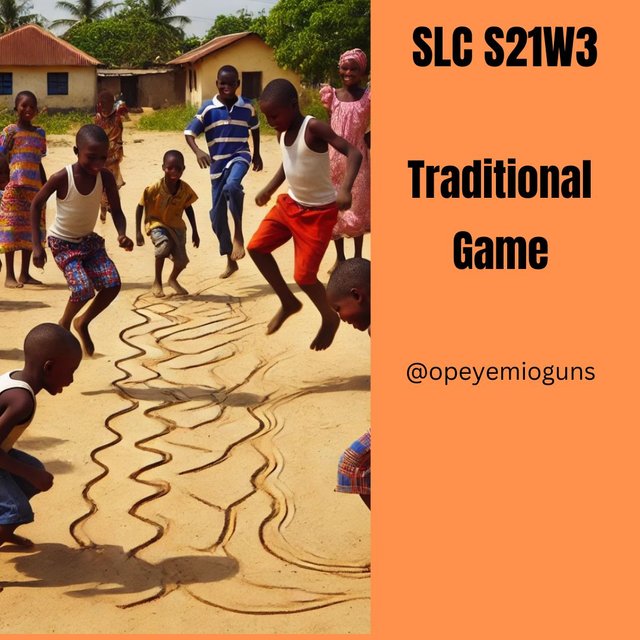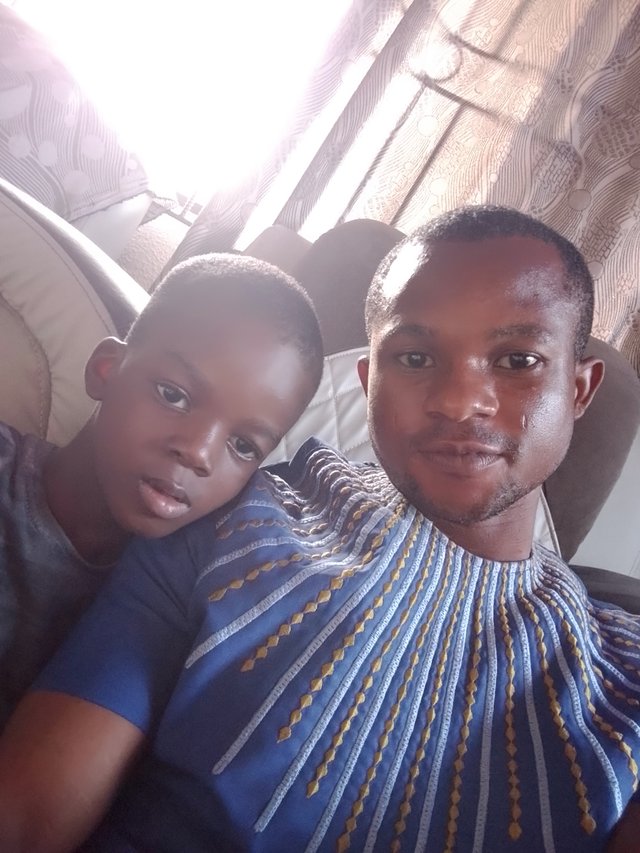SLC S21W3/ Traditional Games
Invite one or more children between 4 and 12 years old. Select a traditional game from your country, play with them and answer the following questions:
What is the name of the traditional game you selected? In your own words, explain how to play.
The game is Traditional Yoruba Game: Tinko (One-Leg Jump Game)
Childhood experiences in Yoruba country, Nigeria, have been greatly influenced by traditional games. One such game, often called Tinko or One-Leg Jump, is an engaging and deft exercise that emphasises fun, creativity, and balance.
- How the Game is Played
Participants draw lines on the ground to start the game, usually in a straight or slightly curved pattern. In order to jump along the line, each player must raise one leg off the ground and use just the other leg. Maintaining balance and accuracy is difficult because dropping posture or stepping off the line leads to elimination.
Players alternately hop down the lines, frequently incorporating inventive twists like backward hopping or rhythmically executing songs or chants. As more rules or increasingly intricate patterns are added, the game gets harder and harder.
- Cultural Significance
The Yoruba community values agility, discipline, and healthy competition, which is reflected in this game, which is more than just a recreational activity. Additionally, it promotes social bonding among kids, which builds resilience and teamwork in a fun setting.
- Benefits of the Game
- Physical Development: Improves leg strength, balance, and coordination.
- Mental Focus: Necessitates spatial awareness and focus.
- Social Interaction: Fosters peer friendship.
- Personal Reflections
Playing games like Tinko while growing up in Nigeria was not only about having fun; it was also about making memories and developing life skills. They take us back to a simpler era when play was defined by imagination and connection.
Tinko is a beloved traditional game in Yoruba culture that is worthy of being recognised as an example of Nigerian children's inventiveness and passion.
What are your rules? Did you make any changes to the rules to suit you?
Rules of the Game and My Personal Adjustments
- Original Rules of Tinko
- Start Line: Players must begin their leaps at a distinct line marked on the ground.
- One Leg Only: During their turn, players are required to hop on just one leg. Leg switching is prohibited.
- Players must precisely hop along the given line without straying from it in order to complete the task. 4. In turn-based play, each player hops along the line in turn.
- Disqualification: If a player loses their balance and puts both feet on the ground, they are disqualified. Disengage from the queue.They stabilise themselves with their hands.
- Winner: The player who finishes the hardest patterns or the last person standing wins.
- My Adjustments to the Rules
When I was a kid, my buddies and I added a few unique rules to the game to make it more fun and difficult:
- Extended Patterns: We incorporated curves, zigzags, and loops into the drawn paths in place of a straightforward straight line.
- Timed Turns: To measure agility under pressure and encourage quicker jumps, we gave each player a timer.
- Obstacle Challenges: To make hopping more strategic, little sticks or stones were positioned along the line.
- Reverse jump: After finishing the line ahead, players had to jump backward through it.
- Group Chants: The player bounced while everyone shouted a rhythmic chant, creating a lively and enjoyable atmosphere.
- Impact of the Changes
With these changes, the game became more dynamic and engaging, letting us enjoy ourselves while pushing our boundaries. Timed rotations and barriers added a competitive element, and group chanting improved cooperation and bonding.
In addition to adding excitement, changing the original Tinko rules to fit our tastes maintained the game's core as a happy way to spend time together. The spirit of play never goes out of style, even if the rules change.
Of the characteristics of traditional games that we have discussed, which ones do you think are present in the traditional game you chose?
Although I didn't practice it in this task because there is no one to play it with, I know the clapping game but it's differently play here, not as you described it in the lesson. It is a beloved pastime in Yoruba nation, Nigeria, and many other parts of the world. Children frequently play this engaging and rhythmic game in groups or couples because it is both amusing and instructive. It has strong roots in cultural heritage, creativity, and coordination.
- How to Play the Clapping Game
Two or more players sit or stand face-to-face while playing the game. The fundamental idea is straightforward:
- Clapping Rhythm: Participants clap their hands first, followed by a synchronised clap of their partner's hands.
- Songs and Chants: Players recite chants or sing traditional songs that establish the rhythm and pace while the applause continues. The following are well-known Yoruba clapping game songs: * "Omo Eko, gbo temi o"* (Child of Lagos, listen to me).The song "Suwe suwe" is frequently sung in rounds.
- Increasing Complexity: As the game goes on, the clapping patterns get more complicated, testing players' reflexes and memory.
- Cultural Significance
In Yoruba culture, the clapping game is particularly significant since it fosters child connection. It is frequently played in the neighbourhood, at family get-togethers and at school playtime. In addition to being enjoyable, the game fosters virtues like tenacity, teamwork, and focus.
- Benefits of the Clapping Game
- Cognitive Development: The requirement to retain and adhere to clapping patterns improves focus and memory.
- Motor Skills: The quick hand motions enhance fine motor skills and coordination.
- Social Interaction: The game encourages cooperation and fortifies player friendships.
- Cultural Awareness: Children are taught elements of Yoruba language and culture through traditional songs and chants.
- Variations of the Clapping Game
- Group play: more than two participants create a circle and pass the clapping sequence to one another.
- Speed Challenge involves players accelerating their clapping, which tests their rhythm and reflexes.
- Creative Freestyle: The game gains a creative element when players create their own patterns.
- Personal Experience
The clapping game was a vital component of my early years. During these games, friends share laughs, errors, and victories that will last a lifetime. I will always remember the songs we sung and the patterns we learnt as representations of happiness and community.
The clapping game is a cultural treasure that blends pleasure with education, and it's not only a kid-friendly pastime. Its lasting appeal is a testament to its adaptability and capacity to unite people via shared joy, creativity, and rhythm.
Did the kids have fun? Share your experience playing this traditional game with them. Feel free to tell us about the best moments you experienced during the activity
No matter the age, traditional games have a way of making people laugh and smile. I recently got to play the One-Leg Jump Game (Tinko) with a six-year-old boy, which allowed me to recall my childhood. It was a fantastic event that was full with enthusiasm, humour, and a hint of nostalgia.
- Did We Have Fun?
Of course! The boy was bursting with joy after I taught him how to do it, even if he didn't know how to do it from the first hop because it's a new generation. He initially stumbled a little, but he soon learnt how to hop along the lines we had painted on the ground and balance on one leg. His face lit up with pride each time he made a successful jump without falling, and I couldn't help but encourage him.
- My Experience Playing With Him
I was reminded of how much fun even simple things can be when playing this game. I was reminded of my own youth by the boy's resolve to hop along the queue without stumbling. Once, he threw me a challenge: who could hop the furthest without going off the queue? He won, of course! The high point of the day was his subsequent little victory dance.
- The Best Moments
- His First Success: He eventually finished the line without losing his footing after several unsuccessful tries. His happiness was so precious!
- The Laughter: When I made a joke about falling and losing my equilibrium, we couldn't stop laughing. He kept copying me because it was funny to him.
- A Shared Victory : In the end, we both performed a freestyle line that was full of twists and turns. We were both beaming from ear to ear after that moment of mutual success.
- Reflections
This exercise served as a reminder of the lessons that classic games like Tinko can impart to kids about tenacity, equilibrium, and having fun without the need of electronics or computers. It also helped us bond, which is evidence that even the most basic tasks may bring happiness.
The One-Leg Jump Game serves as a means of communication, education, and memory-making in addition to being a classic game. I learnt to value its ageless appeal and the happiness it offers to anyone who is willing to try it when playing with a small child.
Share videos or photos of yourself doing the activity, remember that you and the child(ren) must appear in the photos
Conclusion
In addition to strengthening social ties and supporting mental and physical health, traditional games are crucial for maintaining cultural heritage. These games, which are frequently handed down through the years, give a sense of continuity and identity by reflecting the values and traditions of many groups. Maintaining traditional games provides an alternative to contemporary entertainment options while also preserving distinctive cultural practices in an increasingly digital world. These games also promote strategy, cooperation, and physical exercise, all of which help players develop important life skills. All things considered, traditional games are not only entertaining but also essential resources for community involvement and cultural education.
Hey teacher @anailuj1992 thanks for this
Hello @sors @cassar @olamideoguns I'm inviting you to participate


https://x.com/opeyemioguns3/status/1857891062783656231?t=Uke7DbZFrJbR_0LZ2lX5IA&s=19
@tipu curate 2
;) Holisss...
--
This is a manual curation from the @tipU Curation Project.
Upvoted 👌 (Mana: 5/8) Get profit votes with @tipU :)